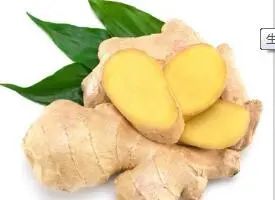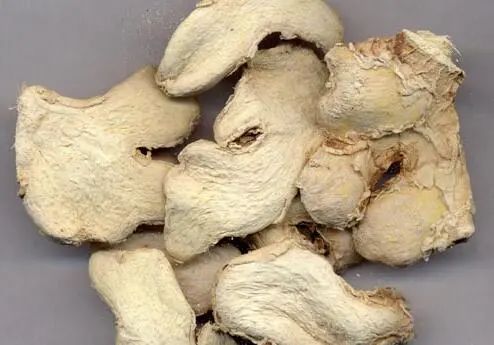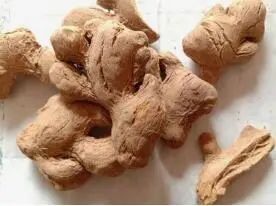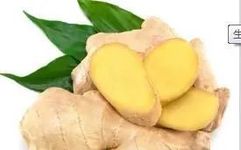Understanding the Differences Among Various Types of Ginger in Traditional Chinese Medicine
 01Fresh Ginger (Sheng Jiang)
01Fresh Ginger (Sheng Jiang) Fresh ginger is the fresh rhizome of the perennial herb Zingiber officinale. It is produced nationwide, harvested in late autumn, and can be used fresh or stored in sand for later use. It has a pungent flavor, is slightly warm in nature, and enters the Lung (Fei) and Spleen (Pi) meridians. It is known for its ability to induce sweating and release the exterior, warm the middle and stop vomiting, and warm the lungs and stop coughing, earning it the title of “the holy medicine for vomiting” in TCM. It can be used to treat conditions such as wind-cold colds, chills and fever, headaches, nasal congestion, vomiting, wheezing, bloating, and diarrhea. Additionally, fresh ginger can detoxify the poisons of Ban Xia (Pinellia ternata), Nan Xing (Arisaema), and seafood.
Fresh ginger is the fresh rhizome of the perennial herb Zingiber officinale. It is produced nationwide, harvested in late autumn, and can be used fresh or stored in sand for later use. It has a pungent flavor, is slightly warm in nature, and enters the Lung (Fei) and Spleen (Pi) meridians. It is known for its ability to induce sweating and release the exterior, warm the middle and stop vomiting, and warm the lungs and stop coughing, earning it the title of “the holy medicine for vomiting” in TCM. It can be used to treat conditions such as wind-cold colds, chills and fever, headaches, nasal congestion, vomiting, wheezing, bloating, and diarrhea. Additionally, fresh ginger can detoxify the poisons of Ban Xia (Pinellia ternata), Nan Xing (Arisaema), and seafood.
02Dried Ginger (Gan Jiang) Dried ginger is the dried rhizome of Zingiber officinale. It is harvested in winter, sliced while fresh, and then dried in the sun or at low temperatures for use. It has a pungent flavor, is hot in nature, and enters the Spleen (Pi), Stomach (Wei), Heart (Xin), and Lung (Fei) meridians. It is effective in warming the middle, dispersing cold, returning yang, and unblocking the meridians. Due to its ability to both warm and disperse, and its hot and dry nature, it is particularly suitable for those with cold-dampness in the middle jiao and for treating wheezing and coughing due to cold phlegm. It is commonly used for abdominal pain due to cold, vomiting, diarrhea, cold limbs with weak pulse, and phlegm-wheezing.
Dried ginger is the dried rhizome of Zingiber officinale. It is harvested in winter, sliced while fresh, and then dried in the sun or at low temperatures for use. It has a pungent flavor, is hot in nature, and enters the Spleen (Pi), Stomach (Wei), Heart (Xin), and Lung (Fei) meridians. It is effective in warming the middle, dispersing cold, returning yang, and unblocking the meridians. Due to its ability to both warm and disperse, and its hot and dry nature, it is particularly suitable for those with cold-dampness in the middle jiao and for treating wheezing and coughing due to cold phlegm. It is commonly used for abdominal pain due to cold, vomiting, diarrhea, cold limbs with weak pulse, and phlegm-wheezing.
03Fried Ginger (Pao Jiang) Fried ginger is made by frying dried ginger until its surface is slightly blackened and the inside turns brown. It has a bitter, pungent, and warm nature, and is effective in warming the middle, dispersing cold, and stopping bleeding. The warming and dispersing properties of fried ginger are milder than those of dried ginger, but it has a longer-lasting effect and is particularly good for warming the middle, alleviating pain, stopping diarrhea, and stopping bleeding. It can be used for abdominal pain, diarrhea due to deficiency-cold, and bleeding due to deficiency-cold.
Fried ginger is made by frying dried ginger until its surface is slightly blackened and the inside turns brown. It has a bitter, pungent, and warm nature, and is effective in warming the middle, dispersing cold, and stopping bleeding. The warming and dispersing properties of fried ginger are milder than those of dried ginger, but it has a longer-lasting effect and is particularly good for warming the middle, alleviating pain, stopping diarrhea, and stopping bleeding. It can be used for abdominal pain, diarrhea due to deficiency-cold, and bleeding due to deficiency-cold.
04Galangal Ginger (Gao Liang Jiang) Galangal ginger is the dried rhizome of the herb Alpinia galanga, also known as good ginger. It is mainly produced in Guangdong, Guangxi, and Taiwan, harvested in late summer to early autumn, dried, and used fresh.
Galangal ginger is the dried rhizome of the herb Alpinia galanga, also known as good ginger. It is mainly produced in Guangdong, Guangxi, and Taiwan, harvested in late summer to early autumn, dried, and used fresh.
It has a pungent flavor, is hot in nature, and enters the Spleen (Pi) and Stomach (Wei) meridians. It is effective in dispersing cold, alleviating pain, and warming the middle to stop vomiting.
It is primarily used to treat conditions such as cold in the middle jiao, abdominal pain, vomiting, and diarrhea.
Fresh ginger disperses and does not retain, focusing on inducing sweating and releasing the exterior; dried ginger can both disperse and retain, focusing on warming the middle and returning yang; fried ginger retains and does not disperse, being milder than dried ginger but specializing in warming the meridians and stopping bleeding; galangal ginger focuses on dispersing cold and alleviating pain, similar to dried ginger but with a stronger warming effect on the stomach.
Applications of Fresh Ginger

 Ginger Tea Ginger tea can dispel external pathogens, invigorate blood circulation, and promote the excretion of metabolic waste, making it an excellent remedy for headaches, febrile diseases, and coughs. The method is to take 10 grams of fresh ginger, slice it, and boil it with 10-6 grams of tea leaves in water. When warm, add honey for a good preventive effect against headaches.
Ginger Tea Ginger tea can dispel external pathogens, invigorate blood circulation, and promote the excretion of metabolic waste, making it an excellent remedy for headaches, febrile diseases, and coughs. The method is to take 10 grams of fresh ginger, slice it, and boil it with 10-6 grams of tea leaves in water. When warm, add honey for a good preventive effect against headaches.
Ginger Foot Soak This is suitable for those with wind-cold colds or who feel cold and fever after being rained on. Use a piece of ginger (about the size of a jujube) smashed, add a portion of safflower wrapped in gauze, and boil it in water with a spoonful of salt for foot soaking. Soak for 15-30 minutes.
Ginger Moxibustion This therapy was first recorded in the Ming Dynasty in Yang Jizhou’s “Great Compendium of Acupuncture and Moxibustion”: “For moxibustion, use ginger, cut into slices like coins, and place them on the tongue point, then moxibustion is applied.” The dual warming effect of moxa and ginger during moxibustion adjusts the body’s functions through meridian points, promoting the flow of qi and blood, and enhancing the body’s ability to resist diseases and expel pathogens.
Cut fresh ginger into 3-4 mm thick slices, puncture many small holes with a needle for better heat conduction; place an appropriate amount of moxa on top, light it, and perform moxibustion until the patient feels warmth, with local skin reddening and sweating. If the initial moxibustion feels burning, slightly lift the ginger slice and then place it back; this burning sensation is not true heat but a stimulation from the ginger, so continue with small moxa. If the pain is unbearable, adjust the ginger slice or place a paper under it before moxibustion.
Vinegar-Pickled Ginger Adding original fragrant vinegar when consuming ginger is a great health method. The sour taste is astringent, which helps to moderate the dispersing power of ginger, making its nature more balanced. Vinegar directly enters the Liver meridian, and when the liver encounters sourness, it contracts, allowing ginger’s uplifting function to also enter the liver, balancing both dispersing and contracting, thus enhancing liver yang energy.
The method is to slice fresh ginger (preferably using fresh ginger), ensuring the slices are not too thick but evenly cut. Place the sliced ginger in a bottle, then pour rice vinegar over it. Ensure the bottle is clean, and the vinegar completely covers the ginger slices. Store the vinegar-pickled ginger in the refrigerator. After a week, you can eat 2-4 slices of fresh ginger daily, which has excellent effects on lowering blood lipids and assisting in the treatment of arthritis.
The vinegar does not need to be consumed; it can be used for dipping dumplings or in cold dishes.



Expert Introduction

Qin Min
Chief TCM Physician
Professor
Master’s Supervisor
Good Doctor of Yangcheng
【Source: Guangdong Second Traditional Chinese Medicine Hospital】


